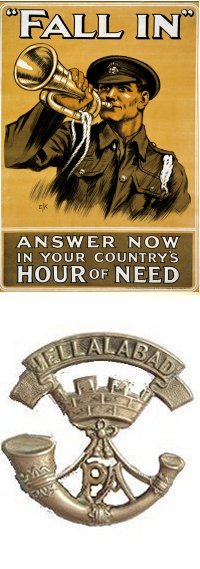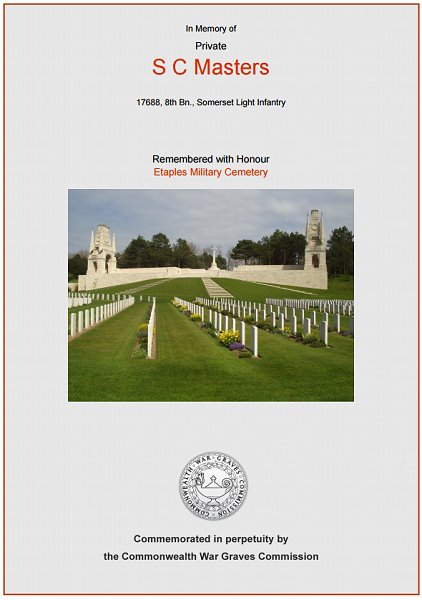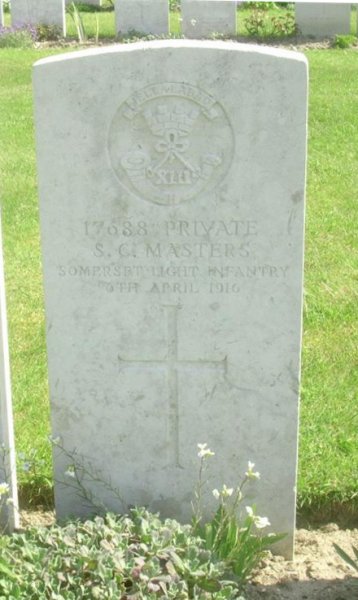yeovil at War
Sidney Charles masters
Died from wounds received on the Western Front
Sidney Charles Masters was born on 11 June 1895 at 25 South Street, Yeovil. He was the son of glove cutter Frederick George Masters (1866-1935) of Yeovil and Emily Delamont née Gillingham (1862-1937), originally from Bridgwater. In the 1901 census Frederick and Emily were listed at 25 South Street with their children; Emily Mildred (b1890), George (b1892), five-year old Sidney and Nellie (b1898).
By the time of the 1911 census the family had moved to 62 Queen Street. With Frederick and Emily were Mildred, George, Sidney and Nellie as well as three new children; Rose Annie (b1901), Minnie (b1904) and Arthur (b1905). 15-year old Sidney gave his occupation as a house boy on a farm - which was Newton Farm run by Mr James. Sidney later worked at the Yeovil Gas Works until his enlistment. The family later moved to Park Street.
 Although
it is not known
when Sidney
enlisted, he
enlisted in
Yeovil joining
8th (Service)
Battalion,
Somerset Light
Infantry. His
Service Number,
17688,
suggesting he
enlisted during
the early part
of
1915.
Although
it is not known
when Sidney
enlisted, he
enlisted in
Yeovil joining
8th (Service)
Battalion,
Somerset Light
Infantry. His
Service Number,
17688,
suggesting he
enlisted during
the early part
of
1915.
The 8th (Service) Battalion was formed at Taunton on 20 October 1914 and came under command of 63rd Brigade, 21st Division. The battalion went to France on 10 September 1915, landing at Le Havre. It is most likely that Sidney went with his battalion at this time.
On 25 September 1915, the 6th, 7th and 8th Battalions of the Somersets became embroiled in the Battle of Loos - the British Army's contribution to the major Allied offensive launched simultaneously with the main French offensive in Champagne. It was the biggest British attack of 1915.
A continuous preliminary bombardment, which showered 250,000 shells on to the German defences over four days, had little real effect. Before sending in the infantry on the morning of 25 September 1915, the British released 140 tons of chlorine gas from 5,000 cylinders placed on the front line to make up for the ineffective artillery barrage. This was the first time the Allies had used the weapon, coming after the Germans employed gas to terrible effect at Ypres in April earlier in the year, and it was hoped it would annihilate the Germans at Loos. However a change in the direction of the wind at several points along the front blew the gas back into the British trenches, causing seven deaths and injuring 2,600 soldiers who had to be withdrawn from the front line. Initially the gas attack created panic among the Germans and close to 600 men were gassed. Despite the setbacks caused by the wind 75,000 British infantrymen still flowed out from the trenches when the order came. British losses at Loos were exceptionally high with 50,000 casualties, including at least 20,000 deaths.
During the Battle of Loos, the 21st Division suffered over 3,800 casualties and took the rest of the year to rebuild. Although the battalion was not directly engaged in any distinct battles until July 1916, the intervening period was one of sustained day-to-day fighting. On 13 March 1916, during such fighting, Sidney was shot and seriously wounded. He died from his wounds on 6 April 1916, aged just 20 years.
In its edition of 6 April 1916 the Western Gazette reported "The parents of Private S Masters, Somerset Light Infantry, who live in Park Street, Yeovil, received news on Monday that he had died from gunshot wounds received in action on March 13th. Private Masters, before joining the Army, was employed on the farm of Mr James, Newton, and also at the Gas Works, leaving the works to join the Army".
Sidney Masters was interred in Etaples Military Cemetery, Pas de Calais, France - Grave V.A.5A, and his name is recorded on the War Memorial in the Borough.
gallery

The Commonwealth War Graves Commission certificate in memory of Sidney Masters.

Sidney Masters' headstone.